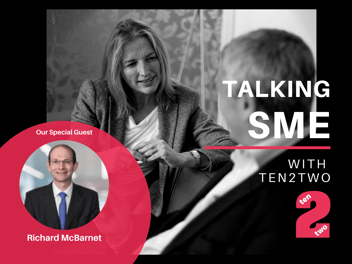Talking SME Podcast: Bringing Tech to your Boardroom
Our latest guest on Ten2Two’s Talking SME podcast is Jim Simpson, Founder and CEO of Ziptech services. In this episode we discuss the changing attitudes Jim has seen towards tech, how it underpins business growth and why it is so important for business leaders to expand their knowledge.
A bit about Jim
Jim founded Ziptech at a time when his frustration with IT Support companies was at its height. Working as a turnaround CEO, he realised that the performance of each of these companies who sought his advice could be remarkably improved with better IT. Jim decided to set up a straight-talking, skilled and well-organised IT service business with customer needs at its heart.
His other passions include his love for his dogs Ben and Mini who can often be found curled up by his desk.
Click here to find out how Ten2Two can help your business survive and thrive.
‘Bringing Tech to your Boardroom’ is just one in our series of podcasts where we talk about a wide range of topics. We talk with business experts, and also offer broad insights to help SMEs become more successful.
If you’re interested in knowing more about the Digital Transformation Director’s Briefings that Jim runs, you can find more information here.
Transcript
Jane O’Gorman (00:00):
Hello and welcome to Talking SME, our quick fire chat with business leaders. I’m Jane O’Goman, director of Ten2Two, experts in flexible recruitment and consulting. I’m very pleased today to welcome Jim Simpson, founder and CEO of Ziptech Services. Hi Jim, welcome and thanks so much for joining me today.
Jim Simpson (00:26):
Hi Jane, that’s no problem at all.
Jane O’Gorman (00:29):
Jim, you founded Ziptech about 17 years ago, I believe. What was the inspiration for you in setting up your own company?
Jim Simpson (00:39):
I had been a turnaround CEO working for VCs, on software companies. And they were all sort of 50 to a 100 person companies and all of them had a problem managing their IT. Previously I’ve worked for bigger companies and I was used to IT just being done for me and now suddenly it wasn’t. So that was really one of the reasons. And the second one, I was approached to manage the operation of a company that had a new kind of technology that allowed support companies to remotely control people’s PCs and servers. So those two things came together and I thought, this is a good idea. I need it and here’s the product that allows me to deliver it. And that’s why I started.
Jane O’Gorman (01:32):
Amazing. Jim, obviously that’s been great 17 years on almost, and here we are. But, what do you feel for you has been the biggest changes that you’ve noticed, say in the workplace since the company first launched?
Jim Simpson (01:50):
I think the way we all work has changed really significantly. You know, everything from turning up to the office every day now to the flexibility of the hours, to where people are located. I used to turn up and wear a collar and tie and all that kind of thing. So it’s changed, it’s changed really radically and personally I love that flexibility and I think that’s been really good. So that’s sort of one of the things.
Jane O’Gorman (02:22):
Absolutely. And I agree, we have seen changing times, particularly post pandemic. I think we’ve seen a big change in that too, which is probably accelerated a little bit, you know.
Jim Simpson (02:34):
The pandemic seems to have accelerated every trend, doesn’t it? And certainly it’s accelerated that one.
Jane O’Gorman (02:41):
For sure. Yeah, for sure.
Jim Simpson (02:43):
The other big change that I think I’ve seen is obviously, you know, Ziptech services is a technology, consulting and outsourcing company. So, I kind of would say this in a sense, but the other big change is in the use of technology that has changed absolutely massively, nothing moves, happens without technology now. And that was different way back in the beginning. And the other thing is the board’s attitude to technology has changed. They used to see technology as a cost and I used to evangelize it as an investment that really helped transform your business. And they would kind of roll their eyes at me. Now they do the opposite. They tell me first before I can say anything, that technology is being used to transform their business. So they’ve really shifted from one extreme to the other.
Jane O’Gorman (03:38):
Yeah. That is quite a shift. It’s a bit like that sense of flexibility, isn’t it, being a bonus rather than something that could be a hindrance. But obviously, it’s been challenging times at the moment. A bit of a volatile climate. What do you see as some of the biggest challenges that businesses and business leaders are facing over the next two to three years?
Jim Simpson (04:04):
I mean, I would say people still. It’s sort of an evergreen challenge, isn’t it? Getting good quality people is really hard. It always has been. I still think it is. And I think people expect much more out of their workplace and their employment. If you don’t live up to that and the way that you treat them and manage them and deal with them. Then they move on very quickly or won’t join you. So I think that that’s a very big challenge. Finding really top quality people. That’s particularly so, that’s why we met of course.
Jane O’Gorman (04:43):
Indeed.
Jim Simpson (04:44):
That’s particularly so, I think in the IT industry because nobody’s using less IT. Everybody’s using significantly more IT post covid and that’s put huge, huge pressure, on the IT industry. I’m not gonna complain about that, but what it means is there are just not enough experienced IT people, technology people to go around. Therefore it’s really hard to get them and keep them. That’s sort of the first one I think. I think the second one is in a way underpinned by technology and is the speed of movement.
Everything moves so fast now. <laugh> We’re all so plugged in, connected, messaging, videos, mobile phones, you know, and if you don’t respond to something immediately or something doesn’t happen immediately, then it’s a problem. So, the cycle time for everything has really, sped up dramatically. The amount of time for everything has reduced and people’s expectations of, how quickly you respond.
Jane O’Gorman (05:53):
Yeah, we’re switched on, aren’t we?
Jim Simpson (05:55):
Yeah, we are.
Jane O’Gorman (05:56):
Indeed.
Jane O’Gorman (06:00):
<laugh>. Why do you think it pays Jim to be a digital savvy director?
Jim Simpson (06:08):
I guess for some of the reasons that we’ve talked about. There is no business that I know. I’m sure there are some out there, but there’s no business that I personally know that is growing significantly without being underpinned by the significant use of technology. And new competitors are springing up in old industries using technology different ways, destroying the incumbents in the previous companies.
So I think that to stay current in this incredibly fast moving world where technology underpins everything, I think directors have to understand the potential of technology. They don’t have to understand how to implement it themselves. And they don’t have to be IT people. They don’t have to be out with their screwdriver or writing code or anything like that, but I think they have to understand what it can do to transform their business. So, see technology from a business perspective. And I think if directors don’t do that then directors in another company will and things move so fast that one could very quickly be uncompetitive.
Jane O’Gorman (07:19):
That’s a really good point. And in fact, touching on that, Jim actually, you set up a directors briefing in 2013 and I think that’s something you run quite regularly in the city and actually even during the pandemic, I think online, so why a directors briefing and why is it important?
Jim Simpson (07:44):
Yeah. We run this at the London School of Economics. And it’s a small group of people. We limit it to about half a dozen and it’s a facilitated discussion around a topic of technology that is relevant to business people. So it’s business oriented, it’s with the business use of technology and how it can transform or change companies. In fact, we don’t invite IT companies, IT people along to it. It’s specifically for business people.
Jane O’Gorman (08:14):
Right.
Jim Simpson (08:14):
We originally set it up for our own clients, because things are changing so fast. We wanted to keep them informed and give them good guidance and advice so they could see these things. So we can actually demonstrate to them and show them, and they get a chance then as well to discuss it with the other half dozen other directors in the room and say, oh yes, we do that already. Or oh, I think that will be useful in my business in that way.
And that benchmarking or sharing of ideas among people I think was really valuable. Then, it became so popular we opened it up to other businesses that we work with and that we know, who aren’t necessarily clients. We’ve now had I think four or five hundred attendees over the years.
Jane O’Gorman (09:00):
Wow.
Jim Simpson (09:00):
And yeah, some CEOs have sent their entire board along to it after they’ve attended it cause it’s the kind of thing…
Jane O’Gorman (09:09):
That’s great!
Jim Simpson (09:10):
Yeah cause it’s not information they’re getting anywhere else cause techies are really bad at bridging this divide between business and technology and the two speak different languages. Therefore I think the business people, aren’t getting this information and that’s why people are sending their whole board.
Jane O’Gorman (09:36):
It makes sense. Definitely makes sense. Do you feel that in some respects perhaps tech is often low on the priority list? I mean obviously you’ve got a great platform there for business leaders to come together and bring that to the boardroom table, but do you feel that tech is often low on the priority list?
Jim Simpson (09:57):
I think it has been in the past. In fact, I mean it’s just been another cost that people didn’t want to deal with and certainly business directors didn’t want to deal with it. Cause they didn’t really understand it. Now, I think it has a much higher profile and directors, boards are aware that it is transforming whatever industry they’re in and also it’s an increasing chunk of their cost base. So they have to understand it and they have to know about it properly.
Jane O’Gorman (10:31):
Indeed, absolutely. What do you think, what more do you think could be done though, Jim. To enhance the awareness of good tech or to bring it to the boardroom table?
Jim Simpson (10:42):
I think, yes there is a responsibility for the technology industry, to speak in business language and, be very clear about what these technologies and stuff will do. At the end of the day I think, I understand why many directors or boards are sort of afraid of technology cause it’s incredibly foreign. But I think that they have to get out of their comfort zone and they have to go to events like this.
Now, I wouldn’t recommend that they go to a techie event cause that will be a waste of time. But a sort of business led event about technology. I think they have to find out more, and they will end up going to some things where they’ll be scratching their head. But I think they need to immerse themselves a little bit more and expose themselves just a little bit more to this kind of technology. Cause if they don’t do it, their competitors will be and certainly younger people coming up, will be.
Jane O’Gorman (11:40):
Yeah, good point. That’s very, very valuable. If there’s one piece of advice or a tip that you could give, a final tip that you could give for business leaders today, what would it be Jim?
Jim Simpson (11:56):
One of the things that surprises me, you know, technology is fundamentally important to businesses now, nothing happens without it. Orders aren’t sent out, money isn’t collected, people aren’t hired, nothing happens without IT, without technology. Yet most SMEs do not have a written technology plan, yet this area is transforming businesses.
So I think I would suggest to write a technology plan, just a couple of pages. Where are you looking to go with technology? How are you looking for it to transform your business? And in what ways? What is your quarterly plan for the next say 12 to 24 months of the projects you need to do? What are the budgets for this and what are the justifications? And people don’t have that simple couple of page plan, but they almost certainly have it for every other part of their business.
Jane O’Gorman (13:00):
Yeah, that’s a really interesting point you make thinking about it Jim. In the sense of if you’re looking at forecasting, budgeting, planning. In terms of actually formalizing the tech and really bringing that into the board discussion.
Jim Simpson (13:17):
And I think if people took up that challenge and they sat down with a blank page and they couldn’t write a plan, I think they know in a technology driven world, they then have got a problem. Because everybody needs to be able to write that. So if you can’t, then that’s exactly where I think you need to go out and immerse yourself and spend more time understanding and learning about it.
Jane O’Gorman (13:46):
Very helpful. And I guess, there’s a starting point there somewhere. I’m sure there’s foundation there, but there’s a starting point there somewhere to bring that higher up on the agenda. Are you finding that from your experience, are you seeing a shift in that? Are you seeing companies embrace tech in this way?
Jim Simpson (14:08):
Yes, we definitely are. So one of the things that, you know, we started off as a help desk and we’ve evolved the service that we provide, outsourcing and consulting service, we provide really dramatically to clients. An important part of what we now do is we do formal quarterly reviews with all of our clients that we do the support and help desk for and we do exactly that kind of thing.
We look at, what is the strategy, what is the plan, what are the budgets and what are the issues that are coming up? And we present that in a way, a minimum of once a quarter more often if they want to, but a minimum of once a quarter they can literally take that material and bring it into the board meeting. In fact, now a number of our clients, we employ a number of chief technical officers who work for our clients on a sort of part-time or fractional basis. The Ziptech CTO that they use very often is now invited into the actual board meeting.
Jane O’Gorman (15:12):
Right. That’s a shift.
Jim Simpson (15:15):
That would never have happened ten years ago, even five years ago.
Jane O’Gorman (15:18):
No. And in fact, yeah, that shows the changes in the workplace, doesn’t it?
Jim Simpson (15:23):
It does.
Jane O’Gorman (15:23):
That’s so helpful Jim. That’s been really, really useful and helpful to have the chat with you today. Thank you so much for joining me and it has been a pleasure talking to you.
Jim Simpson (15:37):
Lovely, thank you very much indeed, Jane.
Jane O’Gorman (15:39):
You’re welcome. And to our listeners, I hope you enjoyed our Talking SME. Look out for future episodes coming soon from Ten2Two experts in flexible recruitment and consulting.


 Back to resources
Back to resources 14 min read
14 min read








